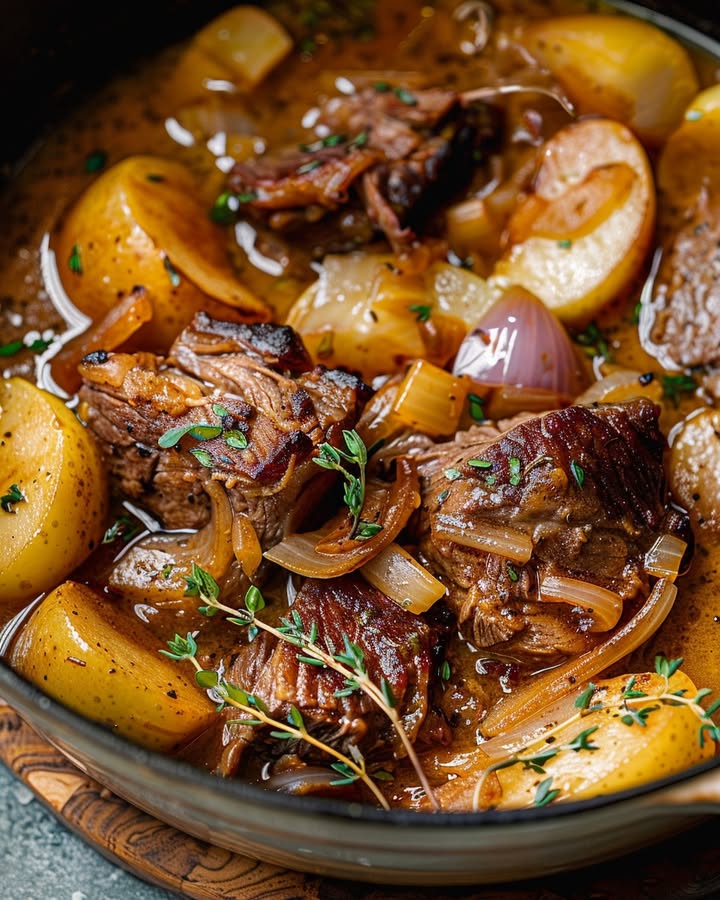Best Cider Braised Beef with Apples and Onions: A Fall Comfort Classic
Nothing warms the soul quite like the Best Cider Braised Beef with Apples and Onions. This hearty dish combines tender beef with the sweet-tart flavors of apples and the rich depth of caramelized onions. As the beef slow-cooks in apple cider, it absorbs all those wonderful autumn flavors, resulting in a meal that feels like a cozy hug.
Imagine pulling apart fork-tender beef that melts in your mouth, infused with the subtle sweetness of apples and the savory notes of thyme. The onions break down into a silky sauce that coats every bite. Whether you serve it over mashed potatoes or with crusty bread, this Best Cider Braised Beef with Apples and Onions will become an instant family favorite.
Quick Recipe Highlights
- Flavor Profile: The combination of savory beef, sweet apples, and aromatic thyme creates a balanced taste that delights the palate.
- Texture: The beef becomes incredibly tender during braising, while the apples soften just enough to retain a slight bite.
- Aroma: As it cooks, the scent of cider, beef, and herbs fills your kitchen with an irresistible warmth.
- Visual Appeal: The deep brown beef contrasts beautifully with the golden apples and onions, making it as pretty as it is delicious.
- Skill Level Needed: While this recipe requires some patience, the techniques are straightforward and manageable for most home cooks.
- Special Equipment: A heavy-bottomed Dutch oven works best for even heat distribution during braising.
Recipe Overview
- Difficulty Level: This recipe earns its intermediate rating due to the browning technique and long cooking time, but the steps themselves are simple.
- Category: Perfect as a main course for family dinners or special occasions, this dish falls squarely in the comfort food category.
- Cuisine: With roots in European peasant cooking, this braised beef recipe adapts beautifully to American autumn traditions.
- Cost: Using affordable chuck roast keeps this meal budget-friendly while delivering premium flavor.
- Season: Fall and winter provide the ideal weather for this warming dish, though it works year-round.
- Occasion: Serve this at holiday gatherings, Sunday suppers, or anytime you want to impress with minimal effort.
Why You’ll Love This Recipe
The Best Cider Braised Beef with Apples and Onions delivers exceptional flavor with relatively simple preparation. Unlike many fancy dishes that require constant attention, this one mostly cooks itself once you get it started. The long braising time transforms an inexpensive cut of beef into something extraordinary.
Nutritionally, this dish packs protein and iron from the beef while getting natural sweetness from apples rather than added sugar. The apples also contribute fiber and vitamin C, making this comfort food somewhat virtuous. For entertaining, it’s perfect because you can make it ahead and simply reheat before serving.
Cost-conscious cooks appreciate how this recipe makes the most of budget-friendly ingredients. A chuck roast costs far less than premium cuts but becomes just as tender through braising. Local apples and basic pantry staples round out the ingredient list without breaking the bank.
The social value of this dish can’t be overstated. It creates an instant cozy atmosphere that encourages lingering at the table. Guests always feel special when served this impressive yet unfussy meal. Leftovers taste even better the next day, making it practical for busy households.
Accessibility makes this recipe a winner too. While it tastes gourmet, it uses ingredients available at any supermarket. You don’t need special skills or equipment beyond a heavy pot and some patience. The recipe adapts easily to different tastes by adjusting the herbs or cider sweetness.
Historical Background and Cultural Significance
Braising meat with fruit dates back centuries in European cooking traditions. Before modern refrigeration, combining meat with acidic ingredients like cider helped preserve and tenderize tougher cuts. The technique became particularly popular in regions with apple orchards, where cider was plentiful.
In America, colonists adapted these Old World methods using local ingredients. Apple cultivation thrived in many colonies, making cider a common cooking liquid. The combination of beef with apples and onions became especially popular in New England, where all three ingredients were readily available.
Over time, the recipe evolved from practical peasant food to celebratory fare. Today’s versions often use better cuts of meat, but the spirit remains the same – transforming humble ingredients into something extraordinary through slow cooking. Regional variations might include different herbs or the addition of root vegetables.
Modern interpretations balance tradition with contemporary tastes. While purists might stick to simple seasoning, many cooks now add layers of flavor with mustard, Worcestershire sauce, or other enhancements. The basic formula remains timeless though – beef, apples, onions, and cider create magic together.
Ingredient Deep Dive
Chuck roast forms the foundation of the Best Cider Braised Beef with Apples and Onions. This well-marbled cut from the shoulder becomes incredibly tender when braised. The connective tissue breaks down into gelatin, creating that luxurious mouthfeel. Look for roast with even marbling and a bright red color. Store it in the coldest part of your refrigerator for up to three days before cooking.
Apples bring natural sweetness and acidity to balance the rich beef. Choose firm varieties like Granny Smith or Honeycrisp that hold their shape during cooking. Their tartness cuts through the fat beautifully. Store apples in the crisper drawer away from other produce. For substitutions, pears work well though they’ll cook faster.
Onions form the flavor base, caramelizing to add depth and sweetness. Yellow onions offer the best balance of flavor and texture. They should feel firm with dry, papery skins. Store them in a cool, dark place with good air circulation. Shallots make an elegant substitute but require less cooking time.
Apple cider provides the braising liquid that ties everything together. Look for fresh, unfiltered cider without preservatives for the best flavor. If unavailable, mix apple juice with a splash of apple cider vinegar. Hard cider adds complexity for adult versions. Store opened cider in the refrigerator and use within a week.
Common Mistakes to Avoid
- Skipping the browning step robs the dish of deep flavor. Take time to properly sear the beef on all sides.
- Using the wrong apple variety leads to mushy texture. Firm apples hold up better during long cooking.
- Overcrowding the pan prevents proper browning. Work in batches if necessary.
- Boiling instead of simmering makes the beef tough. Maintain a gentle bubble.
- Adding salt too early can draw out moisture. Season in layers throughout cooking.
- Not skimming fat results in a greasy sauce. Remove excess fat after cooking.
- Cutting the beef too small causes it to dry out. Larger chunks stay juicier.
- Using low-quality cider impacts overall flavor. Splurge on good local cider.
Essential Techniques
Browning the beef properly creates the foundation for great flavor. Pat the meat dry first to ensure good searing. Use high heat and don’t move the pieces until they release easily from the pan. This Maillard reaction develops complex flavors that water-based cooking can’t achieve.
Deglazing captures all those tasty browned bits. After removing the beef, add liquid to the hot pan and scrape vigorously. This step incorporates concentrated flavor into your sauce. Apple cider works perfectly here, but broth or wine also do the job.
Low-and-slow braising transforms tough meat into tenderness. Keep the liquid at a bare simmer – small bubbles should just break the surface. This gentle cooking breaks down collagen without toughening proteins. Check occasionally to ensure proper liquid levels.
Resting allows the meat to reabsorb juices. After cooking, let the beef sit in the warm sauce for 10-15 minutes before serving. This prevents dryness and lets flavors meld. The wait makes all the difference in texture.
Pro Tips for Perfect Best Cider Braised Beef with Apples and Onions
- For deeper flavor, marinate the beef overnight in cider with herbs.
- Use kitchen twine to tie irregularly shaped roasts for even cooking.
- Add a tablespoon of tomato paste during browning for richer color.
- Layer flavors by seasoning at each step rather than all at once.
- Finish with a splash of fresh cider to brighten the sauce before serving.
- Let leftovers cool completely before refrigerating to prevent toughness.
Variations and Adaptations
For a heartier version, add root vegetables like carrots or parsnips during the last hour of cooking. They’ll absorb the delicious braising liquid while maintaining texture. Mushrooms also make a great addition, adding umami depth to the dish.
Seasonal adaptations keep this recipe fresh year-round. In spring, use young onions and tart green apples. Summer versions might include fresh herbs from the garden. Winter calls for heartier additions like chestnuts or dried fruit.
Dietary modifications are simple. For gluten-free, ensure your cider and broth contain no hidden gluten. Dairy-free needs no adjustments. Low-carb diners can enjoy it over cauliflower mash instead of potatoes. The basic recipe already suits many special diets beautifully.
Serving and Presentation Guide
Traditional plating showcases the beef chunks surrounded by apples and onions, with sauce spooned over. For modern presentation, shred the beef and arrange it artfully with the garnishes. Either way, include plenty of sauce – it’s the best part.
Garnishing options include fresh thyme sprigs, apple slices, or crispy fried onions. A drizzle of reduced cider syrup adds visual appeal. For special occasions, edible flowers make an elegant touch that contrasts nicely with the rustic dish.
Temperature matters – serve piping hot in warmed bowls. The fat in the sauce will congeal if it cools too much. Preheat serving dishes to maintain ideal eating temperature throughout the meal.
Wine and Beverage Pairing
Full-bodied reds like Syrah or Zinfandel stand up to the rich beef flavors. Their fruitiness complements the apples beautifully. For white lovers, an oaked Chardonnay works surprisingly well with its buttery notes.
Non-alcoholic options include sparkling apple cider or ginger beer. The effervescence cuts through the richness. Spiced hot apple cider makes a cozy cold-weather pairing that echoes the dish’s flavors.
Storage and Shelf Life
Refrigerate leftovers in an airtight container for up to four days. The flavors continue developing, often tasting even better the next day. For longer storage, freeze portions for up to three months. Thaw overnight in the refrigerator before reheating gently.
When reheating, do so slowly over low heat to prevent toughness. Add a splash of broth or water if the sauce seems too thick. Microwaving works in a pinch but can make the beef rubbery if overheated.
Make Ahead Strategies
This dish actually benefits from make-ahead preparation. Cook it completely, then cool and refrigerate for up to two days before serving. The resting time allows flavors to meld beautifully. Reheat gently on the stovetop with added liquid if needed.
For partial prep, brown the beef and prepare the braising liquid a day ahead. Store separately in the refrigerator, then combine and cook when ready. This cuts active cooking time when you want to serve the meal.
Scaling Instructions
Doubling the recipe works well if your pot is large enough. Maintain the same ratio of liquid to solids. Cooking time may increase slightly due to volume. For smaller batches, halve all ingredients precisely and use a smaller pot.
When scaling up, brown the beef in batches to avoid steaming. Crowding prevents proper searing. Adjust seasoning carefully at the end – you may need slightly less salt per pound when making larger quantities.
Nutritional Deep Dive
This dish provides high-quality protein from the beef, along with iron and B vitamins. Apples contribute fiber and vitamin C, while onions offer antioxidants. Using cider instead of wine or stock adds natural sweetness without refined sugar.
For lighter versions, trim visible fat from the beef before cooking and skim excess fat from the sauce. The dish remains satisfying while reducing calories. Portion control helps too – a little goes a long way with such rich flavors.
Dietary Adaptations
Gluten-free adaptation requires only verifying your cider and broth contain no gluten. Most do naturally. For paleo, ensure all ingredients meet paleo guidelines. Keto followers can enjoy it by omitting starchy sides and watching portion sizes.
Vegetarians could adapt the concept using mushrooms or seitan, though the character changes completely. Vegan versions might use jackfruit or young jackfruit with vegetable broth, though the texture differs significantly from traditional braised beef.
Troubleshooting Guide
If your beef turns out tough, it likely needed longer cooking time. Return it to the pot with more liquid and simmer gently until tender. For overly sweet results, balance with a splash of vinegar or mustard.
Thin sauce can be reduced by simmering uncovered. If too thick, add more cider or broth. Burnt flavors are harder to fix, but adding liquid and straining can sometimes salvage the dish.
Frequently Asked Questions
Can I use a slow cooker? Absolutely. Brown the beef first for best flavor, then transfer everything to the slow cooker. Cook on low for 8 hours or high for 4-5 hours.
What if I can’t find apple cider? Mix apple juice with a tablespoon of apple cider vinegar per cup as a substitute. The flavor won’t be identical but still delicious.
Can I make this with chicken? While possible, chicken won’t benefit from long braising like beef does. Adjust cooking time significantly downward for poultry.
How do I know when the beef is done? It should shred easily with a fork. If resistant, continue cooking and check every 20 minutes.
Can I freeze leftovers? Yes, it freezes beautifully for up to 3 months. Thaw overnight in the refrigerator before reheating gently.
Additional Resources
For more braising inspiration, explore recipes for coq au vin or pot roast. Mastering basic braising techniques opens up a world of comforting dishes. Consider investing in a quality Dutch oven if you enjoy this cooking method.
Seasonal cooking guides can help you adapt this recipe throughout the year. Farmers market finds often inspire delicious variations. Food science books explain why braising works so well for tough cuts of meat.
PrintBest Cider Braised Beef with Apples and Onions
Description
A hearty and flavorful dish featuring tender braised beef, sweet apples, and caramelized onions in a rich cider sauce.
Ingredients
For the Crust:
- 2 lbs beef chuck, cut into 2-inch cubes
- 2 tbsp olive oil
- 2 large onions, sliced
- 2 apples, cored and sliced
- 2 cups apple cider
- 1 cup beef broth
- 2 tbsp apple cider vinegar
- 1 tsp thyme
- 1 tsp rosemary
- Salt and pepper to taste
Instructions
1. Prepare the Crust:
- Season beef cubes with salt and pepper. Heat olive oil in a large Dutch oven over medium-high heat and brown the beef on all sides. Remove and set aside.
- In the same pot, add onions and cook until softened, about 5 minutes. Add apples and cook for another 3 minutes.
- Return beef to the pot. Add apple cider, beef broth, apple cider vinegar, thyme, and rosemary. Bring to a simmer.
- Cover and reduce heat to low. Braise for 2-2.5 hours, until beef is tender.
- Serve hot, garnished with fresh herbs if desired.
Notes
You can customize the seasonings to taste.





